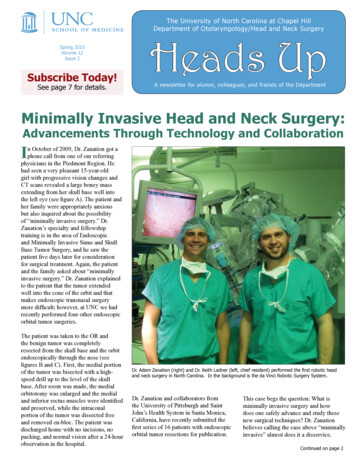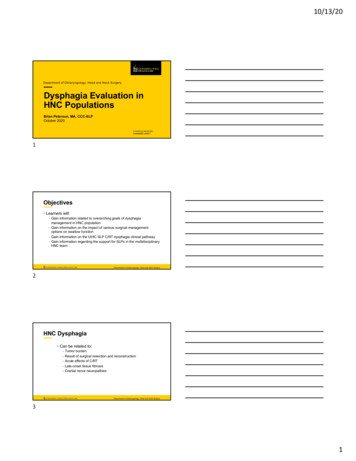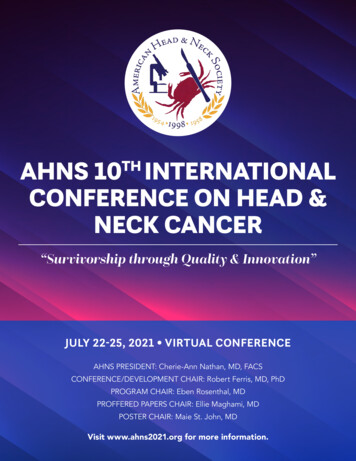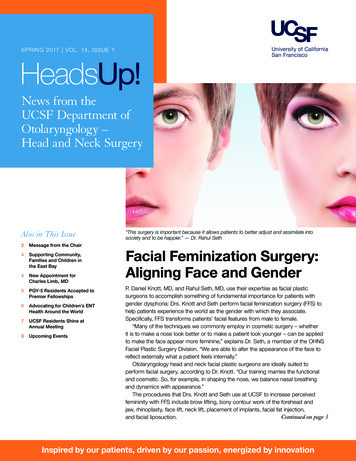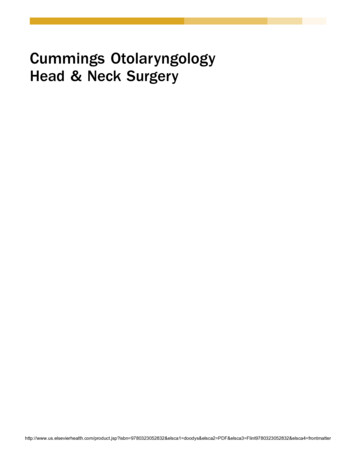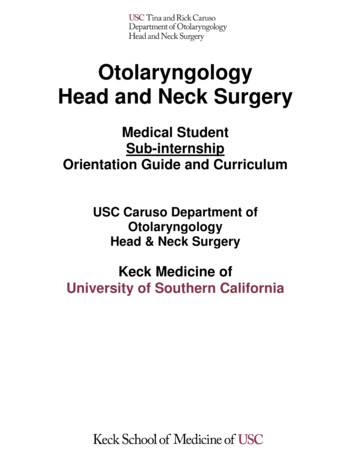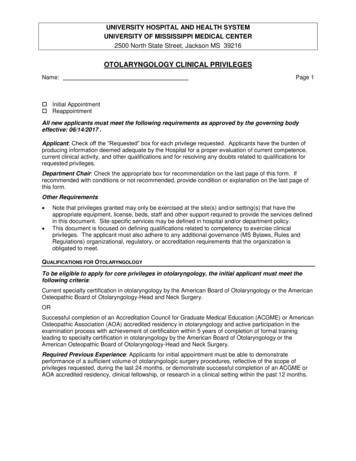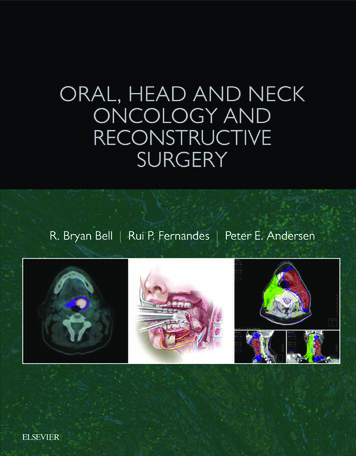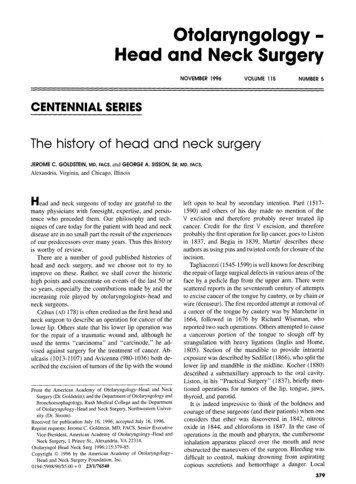
Transcription
Otolaryngology H e a d and Neck SurgeryNOVEMBER 1996VOLUME 115NUMBER 5CENTENNIAL SERIESThe history of head and neck surgeryJEROME C. GOLDSTEIN, MD, FACS,and GEORGE A. SISSON, SR, MD, FACS,Alexandria, Virginia, and Chicago, IllinoisH e a d and neck surgeons of today are grateful to themany physicians with foresight, expertise, and persistence who preceded them. Our philosophy and techniques of care today for the patient with head and neckdisease are in no small part the result of the experiencesof our predecessors over many years. Thus this historyis worthy of review.There are a number of good published histories ofhead and neck surgery, and we choose not to try toimprove on these. Rather, we shall cover the historichigh points and concentrate on events of the last 50 orso years, especially the contributions made by and theincreasing role played by otolaryngologists-head andneck surgeons.Celsus (AD 178) is often credited as the first head andneck surgeon to describe an operation for cancer of thelower lip. Others state that his lower lip operation wasfor the repair of a traumatic wound and, although heused the terms "carcinoma" and "carcinode," he advised against surgery for the treatment of cancer. Abulcasis (1013-1107) and Avicenna (980-1036) both described the excision of tumors of the lip with the woundFrom the American Academy of Otolaryngology-Headand NeckSurgery(Dr. Goldstein);and the Departmentof OtolaryngologyandBronchoesophagology,Rush Medical College and the Departmentof Otolaryngology-Headand Neck Surgery,NorthwesternUniversity (Dr. Sisson).Received for publication July 16, 1996; acceptedJuly 16, 1996.Reprint requests: JeromeC. Goldstein, MD, FACS, SeniorExecutiveVice-President, AmericanAcademy of Otolaryngology-HeadandNeck Surgery, 1 Prince St., Alexandria, VA 22314.Otolaryngol Head Neck Surg 1996;115:379-85.Copyright 1996 by the American Academy of OtolaryngologyHead and Neck Surgery Foundation, Inc.0194-5998/96/ 5-00 0 23/1/76540left open to heal by secondary intention. Par6 (15171590) and others of his day made no mention of theV excision and therefore probably never treated lipcancer. Credit for the first V excision, and thereforeprobably the first operation for lip cancer, goes to Listonin 1837, and Begia in 1839. Martin I describes theseauthors as using pins and twisted cords for closure of theincision.Tagliacozzi (1545-1599) is well known for describingthe repair of large surgical defects in various areas of theface by a pedicle flap from the upper arm. There werescattered reports in the seventeenth century of attemptsto excise cancer of the tongue by cautery, or by chain orwire (rcraseur). The first recorded attempt at removal ofa cancer of the tongue by cautery was by Marchette in1664, followed in 1676 by Richard Wiseman, whoreported two such operations. Others attempted to causea cancerous portion of the tongue to slough off bystrangulation with heavy ligations (Inglis and Home,1805). Section of the mandible to provide intraoraiexposure was described by Sedillot (1866), who split thelower lip and mandible in the midline. Kocher (1880)described a submaxillary approach to the oral cavity.Liston, in his "Practical Surgery" (1837), briefly mentioned operations for tumors of the lip, tongue, jaws,thyroid, and parotid.It is indeed impressive to think of the boldness andcourage of these surgeons (and their patients) when oneconsiders that ether was discovered in 1842, nitrousoxide in 1844, and chloroform in 1847. In the case ofoperations in the mouth and pharynx, the cumbersomeinhalation apparatus placed over the mouth and noseobstructed the maneuvers of the surgeon. Bleeding wasdifficult to control, making drowning from aspiratingcopious secretions and hemorrhage a danger. Local379
O o!c 'yngoiogy Head and Neck SurgeryNovember 1996 811 GOLDSIEIN a n d SISSONanesthesia in the form of cocaine was not discovereduntil 1880, and procaine was discovered in 1923.Even tracheotomy was an operation fraught withcomplications and not widely practiced, either to relieverespiratory obstruction or to prevent the problems ofaspirating blood. Surgical opening of the trachea torelieve respiratory obstruction is mentioned by Galen(AD 131-210), and there are interesting apocryphalreferences to surreptitious prophylactic tracheostomiesin criminals about to be hanged.Another interesting and relevant historic fact is thelack of microscopic identification of cancer before thelate 1800s. Dr. George EIliott in 1885 promoted interestin histopathology by publishing a description of President Grant's cancer of the tonsil-tongue, The famouspathologist Virchow practiced during the late 1800s, andmany are familiar with Sir Morrell Mackenzie' s disputewith the German physicians caring tbr Frederick theNoble. Mackenzie insisted on a tissue diagnosis of cancer by Virchow, but his biopsies were probably inadequate, and the early diagnosis of cancer was not made.Martin 1(p7)describes cancer of the skin, including theface, as seldom diagnosed and treated early. In its earlierstages it was often confused with other ulcerative lesions (syphilis, leprosy, tuberculosis) and therefore neglected, whereas treatment by escharotics--arsenic,zinc, and so forth (Arnott, 1858; Bright, 1871)--wascommonly used rather than surgery. Marsden, whofounded the Royal Cancer Hospital (London) in 1851,stated that the policy of that institution regarding allsuperficial cancers was, "whenever possible to employcaustics, or otherwise avoid the use of the knife. ''I(P 7)Liston in the early 1800s stated, "the patient with cancerof the antrum may be numbered with the dead," and thatits surgical treatment "is totally inadmissible; it is apiece of unmeaning and entirely useless cruelty." As lateas 1908, Mosher referred to operations for cancer of theparanasal sinuses as "palliative" only.Crile in 1906 published his monumental work onneck dissection. This was a turning point in the surgicaltreatment of head and neck cancer; however, progresswas delayed because the operations were lacking insafety, and treatment with radiation therapy was thoughtto be more efficacious. The complications of aggressivetreatment with radiotherapy were significant. GrantWard and Hays Martin arose as strong advocates ofradical surgery as a preference to radiotherapy. Theavailability of antibiotics, safe inhalation anesthesia,and blood transfusions facilitated the success of surgery.The derivation of the term commando resection isinteresting. Typically, a major head and neck resectionwas posted on the operating schedule as, for example,"hemimandibulectomy, radical neck dissection, resec-tion of the base of tongue (or palate or wherever ' heprimary tumor was located) and tracheotomy." Thisusually took up a number of lines on the operating roomschedule but was necessary to let the operating nursesknow which instruments and so forth to have available.Dr. Martin (pr3) states in his book that this operation wasbeing regularly performed at Memorial Hospital in1942, the year of the Allied commando raids on Dieppe.The commandos were admired as courageous heros, andthe residents at Memorial Hospital decided to describethis operative procedure as a "commando" operation,with the suffix denoting the location of the primarytumor. Thus the operation could be listed on the schedule as a "commando-base of tongue" to connote hemimandibulectomy, radical neck dissection, tracheotomy,and resection of the primary tumor. Some years later, Dr.Grant Ward suggested that this connoted an undignifiedassault on the patient, and he preferred the term composite resection.Although, as might be expected, the earliest treatments for head and neck tumors were directed towardeasily accessible lesions of the lips and tongue, it isimpressive to review the early attempts to treat laryngeallesions without anesthesia. Gordon Buck in 1853 described a laryngofissure for excision of cancer This iseven more impressive when one considers that diagnosis was not aided until the introduction of the laryngealmirror in 1854. Laryngectomy gained in favor duringthe first quarter of the twentieth century because of theefforts of St. Clair Thomson in England and ChevalierJackson in the United States. H. B. Sands reported theuse of ether in this operation m 1865. Review of thereports of that period revealed immediate and postoperative mortality in laryngofissure to be in the neighborhood of 30%. The cases were poorly selected, andbecause of the advanced stage of the disease, cures wereseldom, if ever, obtained. In 1878 Paul Bruns concludedthat "the attempt at radical extirpation of cancer of thelarynx by means of thyrotomy has proved itself completely unsatisfactory and worthless."It was not until the 1890s and the early part of thetwentieth century that the operation came Into favor.Again. reference to Sir Morell Mackenzie and consideration of the treatment of Frederick the Noble issignificant. Mackenzie's ostensible reason for not recommending surgery was that no positive biopsy hadbeen obtained, but a review of his publications revealsthat he had no great faith in laryngectomy. In onepublication, he stated that in cancer of the larynx, ' ouraim must be to prolong life when possible, and in everycase to promote euthanasia when the inevitable enddraws near." Martin (pa)states that the earlier meaning ofeuthanasia in Mackenzie's time referred to the less
Otolaryngology Head and Neck SurgeryVolume115 Number5drastic relief of suffering in the terminal stages of cancerby palliative care and the liberal use of sedatives andnarcotics, rather than the current definition of "the actof putting to death . . . which at present is a highlycontroversial matter from moral and legal standpoints."Billroth is credited with having performed the firstsuccessful total laryngectomy for cancer in 1873. Hispatient died of a recurrence 8 months later, and theoperation was not received with great favor. Of Billroth's first 25 surgical cases before 1890, not one patientsurvived a year. Gluck in the 1880s was a strongadvocate of total laryngectomy and even attemptedpharyngolaryngectomy. Gluck vividly described themortality " . . . erysipelas, phlegmon, secondary hemorrhage, mediastinitis, bronchitis and septic bronchopneumonia, septicaemia, s h o c k . . , so that a mortalityof 25% after these operations was really at the time toolow a figure statistically." l(p 8 Solis Cohen (Philadelphia) performed the first American laryngectomy in 1884; the patient survived for 11years. Another patient on whom he performed a laryngectomy in 1894 was the first patient in whom esophageal speech was documentedJ 5By 1926 MacKenty was able to report on more than100 cases, with an operative mortality of only 4%.Martin 1reports that the performance of laryngectomy onan extensive scale began at Memorial Hospital in 1933.His experience is worth repeating.I can well remember in the early 1920s marveling at the firstlaryngectomy that I had ever seen. The patient, Violet D., anactress, had been successfully operated upon by the late H. H.Janeway about 1917 or 1918. She developed an excellentesophageal voice, and I subsequently followed her regularly inthe out-patient department well into the 1930s. At that time,McKenty was the only surgeon in the New York area toperform total laryngectomies frequently. In the early 1920s itwas rather widely believed, especially at Memorial Hospital,that radiation therapy would entirely replace surgery in thetreatment of cancer. As an ambitious young surgeon, I canrecall at that time regretting that I was born too late to everhave the opportunity to perform this operation which seemedto me to have so many fascinating possibilities. The belief inthe 1920s that a total laryngectomy was an outmoded operation has proved to have little foundation. The operation isbeing performed in about 1500 cases in the United Statesannually, and during the last several years, my associates andI at Memorial Hospital have performed it in well over 100cases annually, l p9 Otolaryngology subsequently made significant contributions to the sophistications of partial laryngectomythrough such persons as Alonso, Ogura, Sore, Biller, andPearson.As the advent of antibiotics facilitated the performance of radical head and neck surgery, many thoughtGOLDSTEIN and SISSON 381that they would signal the demise of the specialty ofotolaryngology because otolaryngologists were knownas "the surgeons of infection." Credit must be given to asmall group of otolaryngologists who, fascinated withhead and neck surgery and the possibilities and challenges for otolaryngologists, pursued the field aggressively. It must be remembered that general surgeonslooked down on otolaryngologists becoming involvedin this field because of their lack of training in generalsurgery. Recall that residencies in otolaryngology during that period did not require any exposure to the fieldof general surgery. In the late 1940s and 1950s a numberof otolaryngology residents-in-training at ManhattanEye, Ear, Nose and Throat Hospital enjoyed goingacross the street to watch Hayes Martin operate at Memorial Hospital and to attend his head and neck tumorconferences. Among these observers were Drs. EJohnson Putney, Ed Cocke, W. Franklin Keim, GeorgeSisson, and William TriNe. These pioneering otolaryngologists shared their excitement with others. Dr. JohnConley returned from World War II with significantreconstructive surgical experience and entered practicewith Dr. George Pack in New York City. Dr. Conleyshared his knowledge and experience with many otherotolaryngologists. Other older otolaryngologists saw thefuture of their specialty in this field, men like Drs. JohnBordley, Jerome Hilger, Chevalier Jackson, DeanLierle, John Daly, G. Slaughter Fitz-Hugh, PaulHollinger, Frank Lathrop, Julius McCall, and Joe Ogura.Most of these men were directors of the American Boardof Otolaryngology who saw the need for training ingeneral surgery and made at least 1 year of generalsurgical residency an additional requirement for boardcertification in otolaryngology.The history of medicine shows that physicians whodevelop a particular interest soon form an associationwith others similarly inclined, to share their knowledgeand experience. The general and plastic surgeons doingthis work formed the Society of Head and Neck Surgeons (SHNS) in 1956 and excluded otolaryngologistsfrom participation in this organization. Dr. Hayes Martin, the previously mentioned Chief of Head and NeckSurgery at Memorial Hospital, was a primary founder ofthe SHNS and looked down on i'ears, nose and throaters" doing this work. The American Academy of Ophthalmology and Otolaryngology established a committee on head and neck surgery so that this group of"young Turks," as they (that is, the aforementionedgroup of otolaryngologists interested in this field) wereknown could have a "study club" and a place to meetat the annual academy meeting. The previously mentioned group was now augmented by Dr. John Lewis,who had a residency in general surgery, and Dr. John
382GOLDSTEIN a n d SISSONLord, who was board certified in both general surgeryand otolaryngology. Dr. George Sisson, in his book, TheHead and Neck Story, 6 dramatically describes the evolution of this group and how it was fortunately encouraged by three senior statesmen in the specialty, Drs.Gordon Hoople, Dean Lierle, and Leroy Schall (Professor and Chairman at Harvard, who was talked intochairing this committee). Sisson describes how thisAcademy "Head and Neck Study Group" had its firstmeeting at the Palmer House in Chicago on October 13,1957, and discussed the pros and cons of forming asociety of head and neck surgeons within otolaryngology. The culmination of this dialog was the formation ofthe American Society for Head and Neck Surgery(ASHNS) the following year. The details of the formation and evolution of this group are detailed in theaforementioned book by Dr. Sisson, which is availablein a very limited quantity from the American Academyof Otolaryngology-Head and Neck Surgery.There initially was significant hosti!ity and distrustbetween the otolaryngology members of the ASHNSand the general and plastic surgeon members of theSHNS. Rational members of the leadership of each ofthese head and neck surgical societies recognized thatthe members of both societies had the same objective:to optimize the quality of care of the patient with headand neck disease. With this as a basis for dialog, theleadership of both societies began meeting on a regularbasis at least twice a year to discuss problems of mutualconcern. Early on, there was agreement to share educational opportunities and to come to agreement on whatshould constitute the training of a head and neck surgeon. Dr. Jack Lord, Director of the OtolaryngologyResidency Program in Buffalo, New York, board certified in both general surgery and otolaryngology, and amember of both of the head and neck societies, had morecredibility with the leadership of SHNS than manylesser trained individuals. At a joint; meeting of thecouncils of both societies in 1977, Dr. Lord was appointed to head a joint committee of the two societies todecide what should constitute the training of a head madneck surgeon. This appointment followed some 10 yearsof involved evaluations of what this education shouldbe by separate committees in each society. Dr. HarrySouthwick chaired such a committee for the SHNS in1968 and was succeeded by Dr. Lord as chairman in1974. Dr. Lord chaired a similar committee for theASHNS in 1968; that committee consisted of Drs.John Conley, John Daly, Joe Ogura, Don Shumrick,George Sisson, Walter Work, and then-President FrankKeim.6(p 0 The joint committee was composed of anequal number of members from the two societies andconcluded that fellowships should be established forOtolaryngoiogy Hec d and Neck SurgeryNovember 1996postresidency training and should consist of a balancedoncologic experience with exposure not only to surgery but also to all of the modalities involved in thetreatment of a patient with head and neck cancer. Thejoint committee also concluded that certified graduatesof residency programs in either general surgery, plasticsurgery, or otolaryngology would be eligible for postgraduate fellowships to be approved by the jointcommittee. Site visits were made by members of thejoint committee to those institutions desiring to havesuch a fellowship. The surveyors were experiencedhead and neck surgeons from otolaryngology, generalsurgery, and plastic surgery, and they subsequentlyapproved fellowships at Northwestern (Dr. Sisson),M.D. Anderson (Dr. Goepfert and Dr. Jesse), MemorialHospital (Dr. Strong), University of Toronto (Dr.Bryce), Stanford University (Dr. Fee), University ofArkansas (Dr. Suen), University of Texas-GalvestonMedical Branch (Dr. Bailey), University of Cincinnati(Dr. Shurm'ick), University of Virginia (Dr. Cantrell),Montefiore Medical Center (Dr. Silver), Albany (Dr.Goldstein), University of Alabama (Dr. Mattox), andBuffalo (Dr. Lord). 6 p108)Dr. Lord shepherded this jointfellowship accreditation committee for more than 15years and deserves significant credit for the successof this program. Today, there are 22 approved fellowships, 19 of which are based in departments ofotolaryngology, and now are of 2 years' duration. Theprocess by which these programs are accredited by thetwo head and neck societies is truly a model for theapproval of fellowships in other specialty areas.In New York, Dr. Martin was succeeded as Chief ofthe Head and Neck Service at Memorial Hospital by Dr.Edgar Frazell, who perpetuated similar attitudes. Thenext Chief was Dr. Elliot Strong. Dr. Strong was anoutstanding techincal surgeon who was widely respected for his principles, ethics, and ideals. He demonstrated an early appreciation for the skills of theotolaryngologist in head and neck surgery. In 1981 hebecame a Fellow of the ASHNS and soon thereafterbecame a member of the Council of that Society. In 1982he made an otolaryngologist. Dr. Roy Sessions, a member of his head and neck team at Memorial Hospital, andDr. Sessions stayed there for some 8 years, leaving in1989 to become Chairman of Otolaryngology--Head andNeck Surgery at Georgetown Medical School. Dr. Sessions developed a speech and hearing center while hewas at Memorial Hospital, a fine adjunct to the Head andNeck Service. In 1986 Dr. Strong applied for and waselected to Fellowship in the American Academy of Otolaryngology-Head and Neck Surgery, the first nonotolaryngologist general surgeon to do so. This served asanother manifestation of his influence on the improved
Otolaryngology Head and Neck SurgeryVolume 115 Number 5relationship between general surgery and otolaryngology-head and neck surgery.In recognition of the similar objectives and interestsof the two societies, the ASHNS and SHNS have hadsuccessful joint meetings of the two societies in 1973 inHot Springs, Virginia, 1976 in San Diego, 1978 inToronto, 1981 in Phoenix, and 1985 in Puerto Rico.International meetings were jointly sponsored by thetwo societies in 1984 in Baltimore, 1988 in Boston,1992 in San Francisco, and 1996 in Toronto.These joint meetings have led to a rapprochement,and therefore the hostility and distrust of the early yearshas, to a significant extent, disappeared. There has beenrepeated consideration over the years to merging the twosocieties, but that degree of rapprochement has not yetbeen reached. Today several hundred otolaryngologistsare members of the SHNS as well as the ASHNS, JackLor6 has been President of the SHNS, and the HaysMartin Lecture at SHNS has been given by a number ofotolaryngologists in recent years. This represents quitean evolution from the early days of Dr. Martin's influence on the policies of the SHNS.Otolaryngologists have made a number of significantcontributions to the treatment of the patient with headand neck cancer. Their contributions to conservationlaryngeal surgery have previously been mentioned. Another significant contribution was the introduction ofcryosurgery by Dr. Daniel Miller. Dr. Miller was Chiefof the Head and Neck Oncology Clinic of the SydneyFarber Institute in Boston and was the eleventh president of the ASHNS from 1974 to 1975. Dr. Miller wasan enormous contributor to work in the field of head andneck surgery, especially in the exploration of multidisciplinary approaches to treatment combining the use ofsurgery, radiotherapy, and chemotherapy. In the mid1960s, he explored the use of liquid nitrogen in thetreatment of early tumors, especially those involving thevocal cords. He was a willing teacher of this technique,often visiting medical centers at the request of those whowanted to learn. He was a proponent of the aggressiveuse of liquid nitrogen to treat early tumors and to palliateadvanced recurrent tumors, especially those of thetongue base and antrum.Another innovator was Emmanuel Skolnick, thetwelfth president of the ASHNS, who was an earlyproponent of the preservation of the eleventh nerve inneck dissections, and thus an early proponent of modified neck dissection.The area, or physical dimensions, for which a headand neck surgeon is responsible has changed considerably through the years. It now reaches intracraniallybeyond the base of the skull and down into the mediastinum. George Sisson was an early advocate of theGOLDSTEIN and SISSON383need to enter the upper mediastinum to gain access tolymph nodes potentially involved with disease in recurrent cancer after laryngectomy2 Collaboration withneuro, thoracic, general, and vascular surgeons hasextended boundaries for the otolaryngic head and necksurgeon, and cooperatively new frontiers above the duraand below the pleura have been crossed, but form andfunction have been preserved. Drs. Sisson and Goldstein7-t were early advocates with Dr. Conley of usingregional tissues in the reconstruction of head and neckdefects. Starting in the late 1960s and through the 1970s,they gave courses at the annual Academy meeting in useof grafts and flaps in head and neck surgery. GeorgeReed 11 introduced dermal grafts to otolaryngology in1965, primarily to protect the carotid artery in thosepatients who had a radical neck dissection after heavypreoperative radiotherapy. If skin flaps subsequentlynecrosed, Dr. Reed demonstrated how this graft, whenproperly used, would protect the artery, and indeedmany patients owed their lives to this graft. Ariyan 13in1979 introduced the pectoralis myocutaneous flap, andBlaek et al. t4 popularized its use in otolaryngology. Thisessentially obviated the need for the dermal graft forcarotid artery protection. Goldstein continues to advocate dermis as an intraoral graft, t The advent of microvascular anastomoses enabled free flaps to replaceregional flaps in head and neck reconstruction, 12 andtheir use with bone as a composite flap has facilitatedmandibular replacement. With some reservations wenow say that we've gone about as far as we can go interms of extirpative surgery.Years ago cancer patients were often treated exclusively by either surgical or nonsurgical methods, as wehave portrayed. Standard treatment today for stage IIIand IV tumors is combination therapy. Coincident withadvances in surgical technique and adjuvant therapy isthe obsolescence of some well-known procedures frequently used in the past, such as radical neck dissections.On November 7, 1979, in Washington, D.C., Dr.Bobby Alford, attending one of the last ExecutiveBoard meetings of the old American Academy ofOtolaryngology, commented at length on the future ofotolaryngology. He reported with fervor on the recentproceedings of the U.S. Manpower Commission forMedical Specialties and woefully warned our Executive Committee that soon there would be legislativeincentives to reduce all specialties promulgating thewide use of paramedics. Also, an increase in thenumber of general practitioners would be favored,which in turn would supposedly reduce the totalnumber of specialists, saving Medicare monies in theprocess. Dr. Alford believed that students would
Otolaryngology H e a d an NecR Surgery384GOLDSTEINand SISSONnaturally be discouraged from entering the specialtiesand would opt for family practice. To help stem thisavalanche of projected change, two important groupswere organized by concerned otolaryngologists, theSociety of University Otolaryngologists and the Society of Academic Chairmen of Otolaryngology, whichsubsequently became the Association of AcademicDepartments of Otolaryngology. What an accurateprediction this proved to be!Today in many centers there is a trend toward performing fewer procedures and less aggressive surgerybecause alternative treatments provide patients withoptions. Radical procedures are time consuming, causesignificant morbidity, and require prolonged hospitalization. Although we do not supporl the concept of"rationing" surgery, it is almost certain that limits maybe imposed on us by health care reform. The directionof our state of activity appears to be forcing our medicaltrainers to produce generalists at the expense of specialists, just as Dr. Alford predicted. This not only willdecrease the number of surgeons capable of performingcomplex procedures but also will corr pel physicians touse nonsurgical methods to treat cancer. The bottom lineis, of course, the cost.Exciting strides have been made in head and neckreconstruction. Microvascular surgery has become asuperior technique for the restoration of form, function,and appearance, most notably jaw cor. tour, swallowing,and facial cosmesis. Osseointegrated dental implantsand an improved understanding of the physiology ofswallowing have refined reconstructive techniques.Mandibular repair with distraction osteogenesis andreplacement with biodegradable implant materialsmight well become the state of the art within the nextdecade. Even the realm of functional soft tissue transplantation may be breeched by head and neck surgeonsin the next century.One of our greatest challenges to be faced in thefuture will be to maintain our present high quality ofhead and neck surgical training. Both those who teachand those who train will be hard-pressed to keepabreast of the anticipated changes in surgical equipment and techniques, the increasingly sophisticatedmethods for early cancer detection, contemporaryresearch and research applications, and ever-changingapplications of radiotherapy and chemotherapy and,now, immune therapy and, in the future, geneticmanipulation. Widespread incorporation of modemtechnology with medical training may be limited bystringent health care reform precluding many pastteaching luxuries and may cause gaps in programsbecause resources will be directed elsewhere. Becausemany cancer patients are being treated by other fieldsNovember 1996due to cost and technology, it is uncertain whether inthe future fewer otolaryngology residents witl beallowed to train and whether they will be givenadequate exposure to surgical head and neck cancer.Funding for graduate medical education is beingchallenged. Despite failure to persuade the !03rdCongress to enact widespread health reform in 1994,it is likely that future legislation and market forceswill dramatically alter the current landscape of healthcare. Whether managed care programs will treat cancerpatients locally or refer them at higher cost to a tertiarycare institution is unknown. Whether the cost containment concept of health maintenance organizationswill delay diagnoses in a sufficient number of patientswith head and neck cancer so that greater overallexpenses are eventually generated is also unknown.Overlooked in the rush for cost-containment is thatsociety's ills drive up health care costs. Health careneeds would be quite different if society were free oftobacco, alcohol, drugs, firearms, domestic violence,and poverty. It is inevitable that medical training forthe head and neck surgeon will be di
of Otolaryngology-Head and Neck Surgery, Northwestern Univer- sity (Dr. Sisson). Received for publication July 16, 1996; accepted July 16, 1996. Reprint requests: Jerome C. Goldstein, MD, FACS, Senior Executive Vice-President, American Academy of Otolaryngology-Head and Neck Surgery, 1 Prince St., Alexandria, VA 22314.
